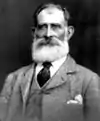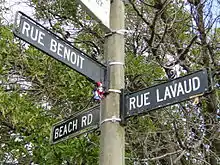Comte de Paris (ship)
The Comte de Paris was a French sailing ship bound for Akaroa, New Zealand, in 1840. The purpose of the voyage was to develop a French colony in the South Island of New Zealand. The voyage was led by the Commissioner of the King of France, Captain Charles Lavaud, who was to represent the French in New Zealand until a governor arrived.
 A memorial commemorating the arrival of the settlers | |
| History | |
|---|---|
| Name: | Comte de Paris |
| Route: | Rochefort, France to Akaroa, New Zealand |
| Launched: | 8 March 1840 |
| Completed: | 13 August 1840 |
| General characteristics | |
| Class and type: | Sailing ship |
| Tonnage: | 501 tonnes |

Preparations
Jean François Langlois was a commander of the French whaling ship Cachalot. He frequently sailed off the coasts of New Zealand and Australia, capturing 45 whales between 1837 and 1839. Approximately 60 French whaling ships were travelling from France to New Zealand and Langlois decided that it would be important to have a French base in New Zealand.
Langlois negotiated with twelve Ngāi Tahu Māori chiefs for ownership of the land. He traded two cloaks, six pairs of trousers, twelve hats, two pairs of shoes, two shirts and some pistols and axes for most of the Banks Peninsula land. In May 1839 he returned to France and formed a small organisation interested in colonising the South Island for the French. The organisation was called Compagnie Nanto-Bordelaise (Nanto-Bordelaise Company).
Compagnie Nanto-Bordelaise obtained King Louis Philippe's signature on 11 December 1839. With permission from the King, they began to prepare for the voyage. The government lent Compagnie Nanto-Bordelaise a 501 tonne whaling ship called Mahé. The Mahé was renamed Comte de Paris after the King’s infant grandson Prince Philippe d'Orléans, Count of Paris, who was born on 24 August 1838.[1] The ship was sent to Rochefort to be outfitted as a whaler because after delivering the settlers, Langlois intended to sail around the waters of New Zealand and Australia.
Voyage
French immigrants travelled from Le Havre to Rochefort on a steamer ship. At Rochefort more immigrants boarded the Comte de Paris. There were 63 immigrants in total and six of them were German. The German passengers boarded when the Comte de Paris started to leak, causing some of the French to abandon the voyage. The Comte de Paris sailed from Rochefort on 8 March 1840.
The voyage got off to a slow start when the steamer towing the Comte de Paris ran into a mud bank. In order to free the Comte de Paris, cargo had to be removed to lighten her load. After ten days the ship was able to continue sailing.[2] The five month passage was uncomfortable because the Comte de Paris steered very badly. [3] The voyage almost came to an end on the night of 11 July. A huge storm off the coast of Tasmania caused lighting to strike the topmast and foremast, nearly capsizing the ship.[4] There were three deaths during the voyage and one birth. Jacques Jotereau, aged 38, died in sight of Banks Peninsula, Jean François Cardin, aged 25, died while anchored at Pigeon Bay and Maguerite David died at the age of four months. Armand Isidore Desprairies Libeau was born on board on 24 April 1840 and was named after the second captain Charles Armand Isidore Desprairies.
Arrival and settlement

The Comte de Paris arrived in Akaroa, New Zealand on 13 August 1840. Unknown to the French and German immigrants, they had landed in a British colony. This is because on 30 February 1840 the South Island chiefs signed the Treaty of Waitangi. The Treaty represents an agreement over land ownership between the British Crown and Māori tribes.[5] The settlers were offered free passage to Tahiti or the Marquesas when they learnt that they had arrived in a British colony. None accepted this offer.[6] The French Government then came to an agreement with the British Government in 1841 that the British Government would protect the rights of the French immigrants in Akaroa. Eventually the settlers were granted official ownership of the land by the British. The immigrants established two small towns in Akaroa and by 1843 they numbered 69 settlers.[7]
The first French baby to be born in Akaroa was Charles Joseph de Malmanche on 19 October 1840. He was born in a tent on the beach to parents Emeri De Malmanche and Rose Jeanne Victoire De Malmanche (née Jerzeau).[8]
In the 1850s the French navy left Akaroa due to the decline in whaling.
Passenger list
The following is the Comte de Paris manifest detailing the names of the founders of the colony of Port Louis-Philippe. Individuals are grouped generally by the family name as at embarkation in Rochefort which may have later changed due to marriage or re-marriage after arrival in 1840.[1][3]
| Family | Members | Nationality | Place of origin |
|---|---|---|---|
| Benoit |
|
||
| Bernard |
|
||
| Bouriaud |
|
||
| Breitmeyer |
|
||
| Cébert |
|
||
| Chardin | |||
| David |
|
||
| Desse |
|
||
| Dulac | |||
| Dupas | |||
| Etéveneaux |
|
||
| Fleuret |
|
||
| François |
|
||
| Gendrot |
|
||
| Guindon |
|
||
| Gurtner |
|
||
| Hahn |
|
||
| Haulmé | |||
| Hettich |
|
||
| Jotereau | |||
| Le Duc |
|
||
| Lelièvre |
|
||
| Libeau |
|
||
| de Malmanche |
|
||
| Massé | |||
| Michel |
|
||
| Pigoulet | |||
| Rousselot |
|
||
| Véron |
|
||
| Vidal |
|
||
| Waeckerle |
|
||
| Walter |
|
||
| Woll |
Armand Isidore Libeau was born on board the Comte de Paris in April 1840 several months before the ship made landfall in the South Island.[1]
Influence on New Zealand

The arrival of the settlers has influenced Akaroa in society today. Some of the street names there today are in French, for example, Rue Balguerie and Rue Benoit. Thousands of descendants in New Zealand also carry French names. Every year in Akaroa a festival is held to celebrate the arrival of the French and German immigrants.[9]
References
- Buick, T. Lindsay (1928). The French at Akaroa. p. 51.
- Crean, Mike (11 July 2008). "Following in their footsteps". The Press. Retrieved 9 May 2014.
- Whitmore, Robbie. "French colonists in Akaroa, South Island". New Zealand in History. Retrieved 9 May 2014.
- Tremewan, Peter (1990). French Akaroa. ISBN 978-1-877257-97-1.
- "Treaty of Waitangi – Te Tiriti o Waitangi". Archives New Zealand. Retrieved 13 May 2014.
- "A Toe-Hold at Akaroa". Retrieved 13 May 2014.
- Copland, Tessa (13 July 2012). "French: The Akaroa settlement". Te Ara – the Encyclopedia of New Zealand. Retrieved 13 May 2014.
- "Charles Joseph de Malmanche". Retrieved 14 May 2014.
- "Comte de Paris descendants". Retrieved 15 May 2014.
